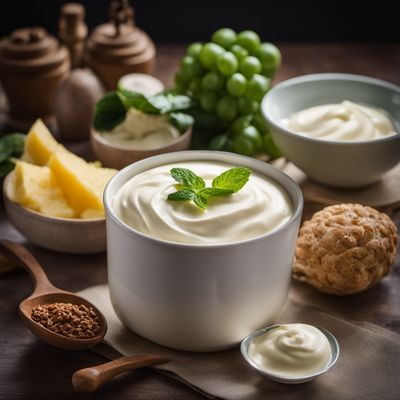
Ingredient
Sour cream products
The Creamy Delight: Unveiling the Versatility of Sour Cream
Sour cream products are dairy-based products made by fermenting regular cream with lactic acid bacteria. They have a smooth and creamy texture with a tangy and slightly acidic taste. The appearance of sour cream products is thick and white, similar to regular cream but with a slightly thicker consistency. They are commonly used as a topping, dip, or ingredient in various recipes, adding richness and depth of flavor.
Origins and history
Sour cream products have their origins in Eastern Europe, particularly in countries like Russia and Ukraine. They were traditionally made by allowing cream to ferment naturally, resulting in the tangy flavor. Sour cream gained popularity in the United States during the 20th century and has since become a staple in many cuisines around the world.
Nutritional information
Sour cream products are a good source of calcium, vitamin A, and protein. They are relatively high in calories, with approximately 50-60 calories per tablespoon, depending on the brand and fat content.
Allergens
Sour cream products may contain milk allergens and should be avoided by individuals with lactose intolerance or milk allergies.
How to select
When selecting sour cream products, look for containers that are tightly sealed and have a fresh expiration date. Check for any signs of spoilage, such as mold or off-putting odors. Opt for products with a higher fat content if you desire a richer and creamier texture.
Storage recommendations
Sour cream products should be stored in the refrigerator at temperatures below 40°F (4°C). Keep them tightly sealed to prevent air exposure, which can lead to spoilage. Consume within the recommended expiration date for optimal freshness.
How to produce
Sour cream products can be produced at home by combining cream with a small amount of buttermilk or lemon juice and allowing it to ferment at room temperature for several hours. However, it is recommended to purchase commercially produced sour cream products for safety and consistency.
Preparation tips
Sour cream products can be used as a topping for baked potatoes, tacos, or soups. They can also be incorporated into dips, dressings, or sauces to add creaminess and tanginess. When using sour cream in hot dishes, it is important to add it towards the end of the cooking process to prevent curdling.
Substitutions
Greek yogurt can be used as a substitute for sour cream products, offering a similar tangy flavor and creamy texture. However, keep in mind that Greek yogurt has a slightly different taste profile, so adjustments may be needed in recipes.
Culinary uses
Sour cream products are commonly used as a topping for Mexican dishes like nachos or enchiladas. They are also a key ingredient in dips such as spinach and artichoke dip or as a base for creamy salad dressings. Sour cream products can be incorporated into baked goods like cakes or muffins to add moisture and richness.
Availability
Sour cream products are commonly available in grocery stores and supermarkets worldwide.
More ingredients from this category
Recipes using Sour cream products » Browse all

French-inspired Pierogi
Pierogi Parisienne: A French Twist on a Polish Classic

Czech Bread Soup
Hearty Czech Delight: Bread Soup

Russian-style Hot Pot
Borscht-inspired Hot Pot: A Hearty Russian Delight

Bortsoki - Russian Beetroot Pancakes
Vibrant Beetroot Delight: Russian Bortsoki Pancakes

Creamy Avocado Soup
Velvety Green Delight: Creamy Avocado Soup

Bosnian Potato and Cheese Casserole
Savory Delight: Bosnian Kljukuša - A Hearty Potato and Cheese Casserole

Colombian Chicken Ajiaco with Avocado and Corn
Hearty Colombian Chicken Ajiaco: A Taste of Comfort and Tradition

Kyalagyosh - Kyrgyz Style Meat Dumplings
Savory Delights: Kyrgyz Kyalagyosh - Traditional Meat Dumplings

Beef Bourguignon
Hearty Russian-style Beef Stew

Krpice sa zeljem (Russian Style)
Savory Russian Cabbage Pasta

Polish-Style Burrito
Pierogi-Inspired Burrito: A Fusion of Polish and Mexican Flavors

Mexican Fiesta Wet Burrito
Savory and Saucy Mexican Fiesta Wet Burrito


